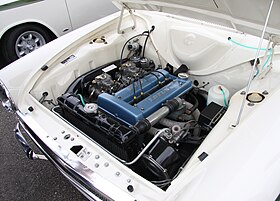| Twin Cam | |
|---|---|
 | |
| Overview | |
| Manufacturer | Lotus Cars |
| Also called | Lotus TwinCam, Cosworth TA |
| Production | 1962–1975 |
| Layout | |
| Configuration | Naturally aspirated I4 |
| Displacement | 1.5 L; 91.4 cu in (1,498 cc) 1.6 L; 95.0 cu in (1,557 cc) 1.6 L; 97.3 cu in (1,594 cc) |
| Cylinder bore | 80.96 mm (3+3⁄16 in) 82.55 mm (3+1⁄4 in) 83.5 mm (3.29 in) |
| Piston stroke | 72+3⁄4 mm (2.86 in) |
| Cylinder block material | Cast iron (Ford 116E) |
| Cylinder head material | Aluminium |
| Valvetrain | Chain driven DOHC, 2 valves per cylinder |
| Compression ratio | 9.5:1, 9.8:1, 10.5:1 |
| Combustion | |
| Fuel system | Dell'Orto, Weber or Stromberg carburettors |
| Fuel type | Petrol |
| Oil system | Wet sump, Dry sump |
| Cooling system | Water-cooled |
| Output | |
| Power output |
|
| Torque output | 102–113 lb⋅ft (138–153 N⋅m) |
| Chronology | |
| Successor | Lotus 907 |
The Lotus-Ford Twin Cam is an inline-four petrol engine developed by Lotus for the 1962 Lotus Elan. A few early examples displaced 1.5 litres, but the majority were 1.55-litre (1557cc) engines. It used a Ford 116E iron cylinder block and a new aluminium cylinder head with dual overhead camshafts. The Twin Cam was used in a variety of vehicles until Lotus stopped production in 1973.[1] It was succeeded by the Lotus 907 engine.
